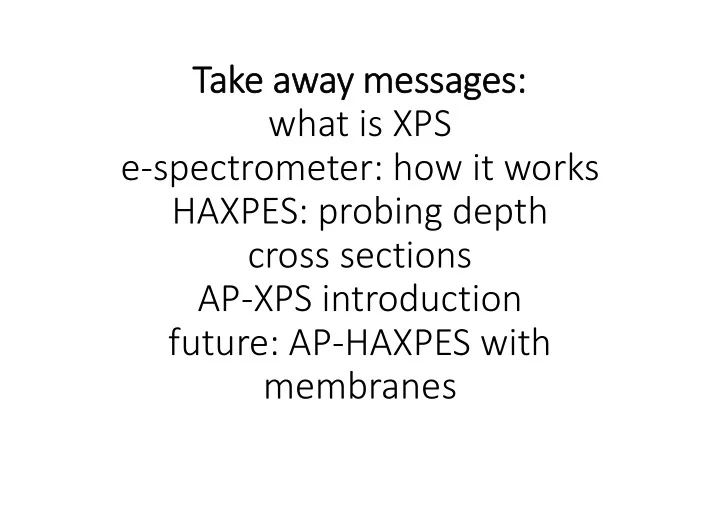

Take away messages: what is XPS e-spectrometer: how it works HAXPES: probing depth cross sections AP-XPS introduction future: AP-HAXPES with membranes
PhotoElectron Spectroscopy (PES) Photo-Emitted electrons Photoelectron Spectroscopy (PES) is a widely used technique to investigate the chemical composition of surfaces. photons Elemental “What is?” composition “How much Quantitative is?” analysis • Irradiate a solid with PES can probe many features of the monoenergetic UV/X-ray radiation electronic structure, thus providing • Analyze the energies of the information useful for the emitted electrons comprehension e.g. of spin/charge transport, magnetic properties, local structural order, etc…
PHOTOELECTRIC EFFECT h e - Valence states E K = h – E B – f AN 2p 2s h : photon energy E B : core level binding energy f AN : work function of the 2p 2s electron analyzer 1. H. Hertz, Ann. Physik 31,983 (1887). 2. A. Einstein, Ann. Physik 17,132 (1905). 1921 Nobel Prize in Physics. 3. K. Siegbahn, Et. Al.,Nova Acta Regiae Soc.Sci., Ser. IV, Vol. 20 (1967). 1981 Nobel Prize in Physics.
Exploiting PES features Atomic specie sensitivity Chemical state sensitivity Spin sensitivity Photon Energy and Polarization dependence Advantages provided by synchrotron radiation sources Tunability in a very large range Very high intensity Good energy resolution Possibility to have polarized light
True success: chemical analysis with laboratory sources X ray tube Reference: hanbook of x ray photoemission spectroscopy
CHEMICAL STATE Copper SENSITIVITY h = 1486.6 eV Core level spectral lines are identified by the shell from which the electron was ejected (1s, 2s, 2p, etc.). Core levels Valence states Spin-orbit splitting
Electron energy analysers Electrostatic energy Time of flight analyser Hemispherical or cilindrical Broad application field with standard and Require pulsed sources, special applications: synchrotron sources Time resolved experiment Angular resolved photoemission
The king of analysers: electrostatic hemispherical analyser 3 parts: input lenses hemisphers detectors
Detectors: electron multipliers Channeltrons Microchannel plate Both require vacuum better than 10-6 mbar!!!
HArd X-ray PhotoElectron Spectroscopy A tool for looking beneath the surface l e enhanced at high energy: this open the possibility to study buried layers in multilayer Photon systems Energy z 2 - 15 keV l I ( z ) e e 1000 HAXPES energy range Probing l e > 50 Å depth up to 30 nm 100 PES typical range l (Å) No need of Low in situ surface 10 sample sensitivity preparation E K = h – E B – f AN l e ~ 5-20 Å 1 1 10 100 1000 10000 Electron KINETIC energy (eV)
z Detector l I ( z ) e e e - d l e enhanced at high z 1 l e energy: this open the e d l e (1 keV) ≈ 1 nm 2 d 1 possibility to study buried l e e layers in multilayer d 2 systems 1000 HAXPES energy range l e > 50 Å l e (6 keV) ≈ 5 nm 100 PES typical range l (Å) l e (9 keV) ≈ 8 nm 10 E K = h – E B – f AN l e ~ 5-20 Å 1 1 10 100 1000 10000 Electron KINETIC energy (eV) l e can be tuned by varying the photon energy
parentheses: the universal curve FAKE! There are different behaviour below 100eV, not universal
The VOLPE Project VOLume PhotoEmission from solids with Synchrotron Radiation 5 th Framework RTD European Project - 3 years (2002-2005) ELETTRA (Trieste), INFM (Rome and Trieste), ESRF (Grenoble), LURE (Paris), EPFL (Lausanne) ,Univ. Neuchatel OBJECTIVES: 20-40 meV Energy resolution @ 6-10 keV 1) High Resolution/High Flux ESRF ID16 beamline 15-100 meV at 8-10 keV 2) Dedicated Spectrometer, power supplies and detector
Low noise detector: Challenges: CROSS SECTION!!! Power supply stability Use the Elettra resource: @HV https://vuo.elettra.eu/services/elements/WebElements.html Return to periodic table
VOLPE apparatus at the ID16 beamline of the ESRF Manipulator with helium cryostat ID16 beamline at ESRF T < 20 K experimental hutch 10 11 photons/s/200 mA EPFL (Switzerland) with D E ≤ 50 meV ESRF, (France) Experimental chamber and sample holder Laboratoire LURE (France) P. Torelli et al. RSI 76 023909 (2005)
Estimation of the bulk sensitivity in HAXPES Bulk sensitivity in PES is typically estimated via measurements of electron effective attenuation length ( l ), the thickness of the overlayer that reduces to 1/e the intensity I S of a core level emission from the substrate. The “overlayer” experiment: I 0 = intensity from the bare substrate x S 0 I ( x ) I e l x T I ( x ) I ( 1 e l ) I T = intensity for an Overlayer: infinite overlayer Co, Cu, Ge, and Gd 2 O 3 PROBING DEPTH ≈ 3 l e M. Sacchi et al., Phys. Rev. B 71 , 155177 (2005)
Bulk vs Surface sensitivity
Change in the partial cross section G. Panaccione, G. Cautero, M. Cautero, A. Fondacaro, M. Grioni, P. Lacovig, G. Monaco, F. Offi, G. Paolicelli, M. Sacchi, N. Stojic, G. Stefani, R. Tommasini and P. Torelli , ”High-energy photoemission in silver: resolving d and sp contributions in valence band spectra”, J. Phys.: Condens. Matter 17 (2005) 2671-2679. G. Panaccione, F. Offi, M. Sacchi and P. Torelli, Hard X-ray PhotoEmission Spectroscopy of strongly correlated systems, Comptes Rendus de Physique 9, 524 (2008)
Ambient pressure XPS Motivation: Problems: -surface structure may differ from what observed in 1) Electron analyser require UHV UHV -Dynamic effect can play a significant role 2) Electron escape depth -Dynimic processes may be studied -Material with high vapor pressure can be studied
Analyser for NAP-XPS (a smart solution…) Several differential pumping stages Input lenses focalize electron in small apertures to help differential pumping Extremely expensive, brute force…………
Example 1: chemical reactivity @ surfaces
Example 2: solid/liquid interfaces
Example 3: the new solution: membranes!
Take away messages: XPS basic principles e-spectrometer: how it works HAXPES: incresed probing depth change in relative (s,p,d) cross sections AP-XPS introduction future: AP-HAXPES with membranes
Recommend
More recommend